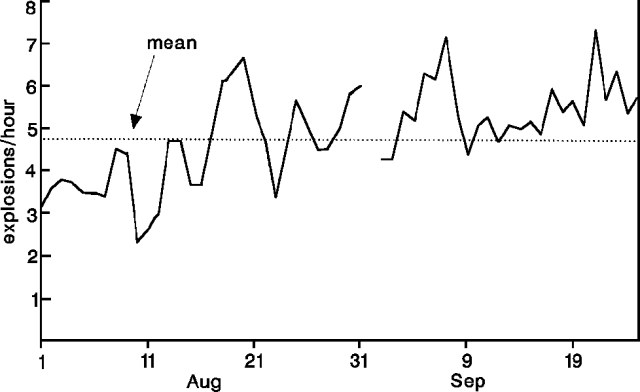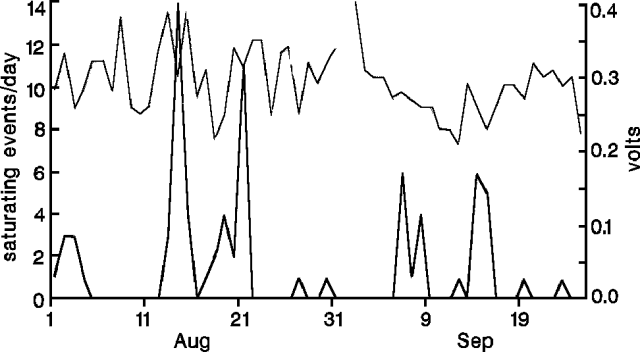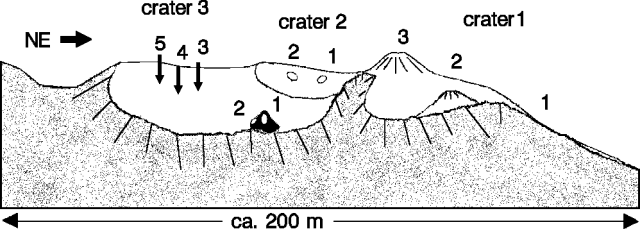Report on Stromboli (Italy) — September 1991
Bulletin of the Global Volcanism Network, vol. 16, no. 9 (September 1991)
Managing Editor: Lindsay McClelland.
Stromboli (Italy) Continued tephra ejection from several vents
Please cite this report as:
Global Volcanism Program, 1991. Report on Stromboli (Italy) (McClelland, L., ed.). Bulletin of the Global Volcanism Network, 16:9. Smithsonian Institution. https://doi.org/10.5479/si.GVP.BGVN199109-211040
Stromboli
Italy
38.789°N, 15.213°E; summit elev. 924 m
All times are local (unless otherwise noted)
Activity was moderate from August through mid-September, with occasional explosions from craters C1 and C3 (about 1-4 hourly/crater). During 1 August to 25 September, the average number of explosion shocks/hour gradually increased to the "normal" value of 6; (figure 20). Relatively low levels of activity lasted from mid-July to mid-August. The number of instrument-saturating events was low and concentrated on a few days during the second week in August, while average tremor amplitude remained relatively stable until it declined in late August (figure 21).
 |
Figure 20. Average number of explosion shocks/hour at Stromboli, 1 August-25 September 1991. The mean value for the period is shown by the dotted line. Courtesy of M. Riuscetti. |
 |
Figure 21. Number of seismometer-saturating events/day (lower curve) and average daily tremor amplitude in volts (upper curve) at Stromboli, 1 August-25 September 1991. Courtesy of M. Riuscetti. |
The following report from Jonathan Dehn and Boris Behncke, on 28-29 August activity, supplements information in 16:8. "During a visit to Stromboli's summit and craters on 28-29 August, the volcano, much less active than during visits in March-April 1990 and November 1990, was in a state similar to that observed in mid-September 1989. Eruptions came from only two vents, one at the NE end of C1 (figure 22), and the other in the center of C3. The former erupted frequently during the evening of 28 August producing fountains up to 150 m high. Such eruptions lasted at least 10 seconds and began without any noticeable premonitory signs. Bombs and spatter fell over much of the C1 area and into C2. After midnight on 29 August, explosions from this vent became much less frequent, averaging 1-2/hour. The other active vent produced ~2-4 explosions/hour but much lower fountains, and ejecta mostly fell back into C3. These explosions were often preceded by an increasingly bright glow from the interior of C3.
 |
Figure 22. Sketch of Stromboli's crater terrace as seen from Pizzo sopra la Fossa, 28-29 August 1991. Features (such as cone at vent 3 in C1) are not to scale. Courtesy of J. Dehn and B. Behncke. |
"During the night, four glowing but not erupting vents (1 and 2 in C2, and 1 and 2 in C3) could be observed, at the same positions as in late 1990. Two more vents (2 and 3) were visible within or near C1. Vent 2 appeared to be a larger pit created by collapse of the former vents 1 and 2. A symmetrical cone ~10 m high had been built around C1's vent 3, feeding a dense gas plume.
"C3 could be approached around daybreak (0530-0630) on 29 August, and observations of the crater's interior and its eruptive activity were made during a 45-minute period. The SW half of the crater was occupied by a pit ~50 m deep. This pit contained at least three active vents, of which two were open and displaying continuous glow and gas emission. Minor spattering from these vents occurred at times, often heralding eruptions from a third vent, in the center of the pit's floor, that was buried under a cover of bombs and scoriae. Eruptions from this vent fragmented the old overlying material, forming diffuse ash plumes followed by the ejection of fresh glowing spatter. All of the ejecta from C3 fell back into the pit and onto its walls, and slumping of material from the pit's walls commonly covered the vent within seconds after each eruption.
"Vents 1 and 2 (in C3) were also observed at close range. They contained small active lava ponds, or molten sulfur, and displayed pulsating gas emission. The ponds were located within a cavern, but no obvious vertical conduit was seen. The rim of C3 was covered with a thin coating of fine tephra and fresh Pele's hair, but no ejecta fell in this area during the stay on the crater rim. From 0630 until about 1100 (29 August), the end of the summit visit, eruptions were separated by intervals ranging from 10 to 40 minutes."
Geological Summary. Spectacular incandescent nighttime explosions at Stromboli have long attracted visitors to the "Lighthouse of the Mediterranean" in the NE Aeolian Islands. This volcano has lent its name to the frequent mild explosive activity that has characterized its eruptions throughout much of historical time. The small island is the emergent summit of a volcano that grew in two main eruptive cycles, the last of which formed the western portion of the island. The Neostromboli eruptive period took place between about 13,000 and 5,000 years ago. The active summit vents are located at the head of the Sciara del Fuoco, a prominent scarp that formed about 5,000 years ago due to a series of slope failures which extends to below sea level. The modern volcano has been constructed within this scarp, which funnels pyroclastic ejecta and lava flows to the NW. Essentially continuous mild Strombolian explosions, sometimes accompanied by lava flows, have been recorded for more than a millennium.
Information Contacts: J. Dehn and B. Behncke, GEOMAR, Kiel; M. Riuscetti, Univ di Udine.

